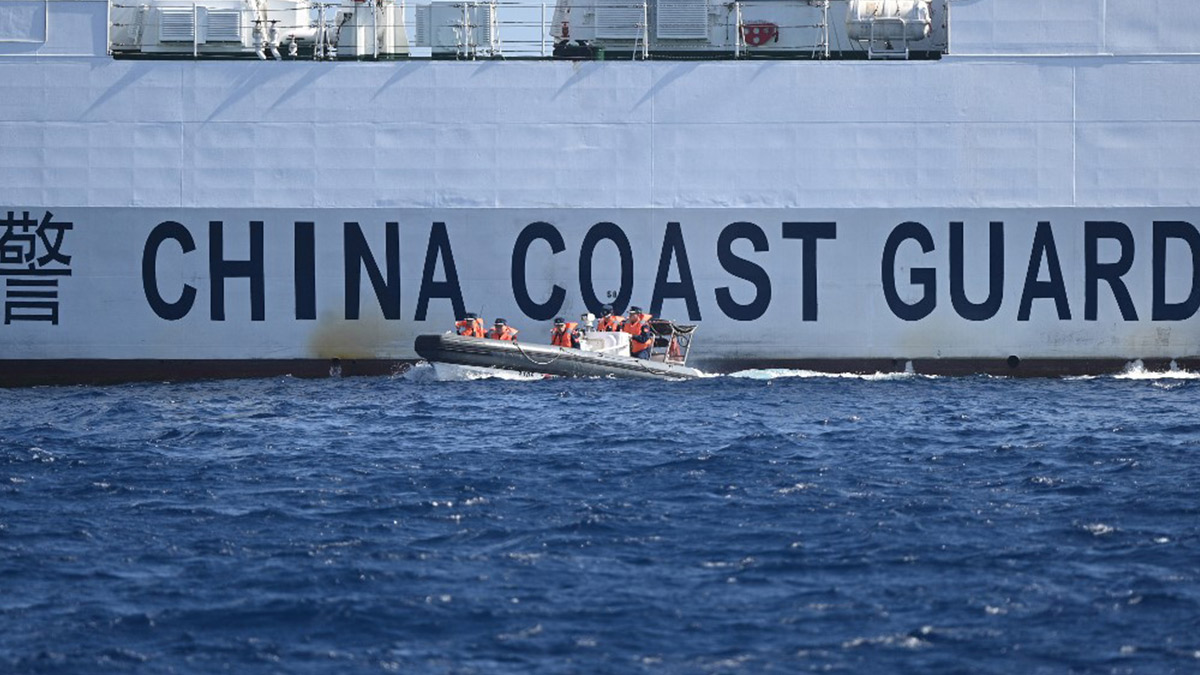
This picture taken on February 16, 2024 shows a rigid hull inflatable boat leaving a Chinese coast guard vessel near the China-controlled Scarborough Shoal in the disputed waters of the South China Sea. (File photo by Ted ALJIBE / AFP)
MANILA, Philippines — The world’s largest coast guard vessel belonging to China entered the West Philippine Sea near Scarborough (Panatag) Shoal on Friday in a move seen by experts as a way for Beijing to assert dominance and “expand its de facto occupation” there.
Ray Powell, director of SeaLight, said over X (formerly Twitter) that “the world’s largest coast guard ship” — a 165-meter CCG (China Coast Guard) vessel with bow number 5901— along with a 102-meter CCG vessel with bow number 5203 were last spotted there at about 5:15 a.m.
Commodore Roy Vincent Trinidad, the Navy spokesperson for the West Philippine Sea, also confirmed this, adding that the two vessels were last seen 50 nautical miles off the atoll.
“There will be an appropriate response from the Philippine Coast Guard (PCG),” Trinidad said in a press conference in Manila.
Powell said the CCG ships “conducted a brief intrusive patrol” inside the country’s exclusive economic zone (EEZ).
“It was an unusual sortie, the purpose of which isn’t very clear to me from the tracking data,” Powell, who heads the program of Stanford University’s Gordian Knot Center for National Security Innovation that tracks Chinese maritime activities in the West Philippine Sea, told INQUIRER.net in a message.
Constant presence a ‘salami-slicing’ move
However, Powell noted that China typically conducts “intrusive patrols deep within the EEZ of neighboring countries… to establish a continuous presence and gradually normalize Chinese jurisdiction over areas granted to its neighbors under international law.”
Don McLain Gill, a lecturer at the De La Salle University’s Department of International Studies, noted that China is seeking to further establish its presence there as a part of Beijing’s “salami-slicing strategy” which, he said, is a strategy it employs “to slowly expand its de facto occupation of particular areas through a mix of non-military means.”
“This is part of an ongoing, but intensifying salami-slicing strategy of Beijing in the West Philippine Sea, which lies in establishing a close to constant presence within Philippine EEZ to eventually alter the status quo and balance of power to its favor without the overt use of military force,” Gill further said in a message to INQUIRER.net.
Such moves align with Beijing’s assertion of sovereignty in almost the entire South China Sea, including most of the West Philippine Sea, even if such a claim has been effectively invalidated by a July 2016 international tribunal which stemmed from a case filed by Manila in 2013.
China continues to reject this ruling.
Power move
“By using its largest Coast Guard vessel, China is also trying to illustrate its dominance and the asymmetry of power between the Philippines and China,” Gill also said.
Security expert Chester Cabalza also said the presence of the ship “is a show of force of Beijing’s might.”
“It symbolizes the Cold War in the Scarborough Shoal,” Cabalza told INQUIRER.net, noting that the move comes as Manila continues to challenge Beijing’s “illegal control” and reported underwater pipe-laying in the atoll.
China seized control of Panatag Shoal’s lagoon in 2012 after its coast guard’s standoff with Philippine vessels, an outright disregard of the international tribunal’s ruling declaring the area a shared fishing ground between China, Philippines and Vietnam.
In a bid to challenge this control which prevents fisherfolk from entering the area, a civilian-led convoy attempted to come near the vicinity of the shoal last week but was blocked by 10 CCG vessels in what the PCG branded as an “overkill” response to only five fishing boats.
READ: China’s new trespassing rule is illegal, illegitimate — experts
Also during this event, China announced a unilateral anti-trespassing policy which encroaches most of the West Philippine Sea to take effect on June 15, according to a South China Morning Post report.